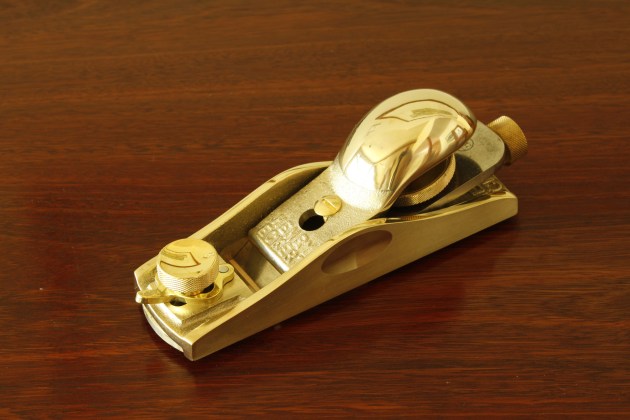TESTED: Henry Eckert 60-1/2 low angle block plane
Words and photos: Raf Nathan
How exciting to see new Australian made tools coming onto the market like this one from South Australia based Henry Eckert Toolworks. I have a thing for block planes and my first thought on viewing the Eckert with its gleaming gold body was that I should add it to my collection.
Virtually all modern block planes designs are based on the Stanley 60-1/2 made in 1900. It was a huge success – you had to have one. Lie-Nielsen set the standard by making a better version. More recently WoodRiver and Luban began making a tool that looks pretty much the same. The Eckert is also 150mm long with a 35mm wide blade and I did wonder why it and the other brands did not take a different approach to appearance; side by side they are the same as the Lie-Nielsen.
Low angle planes with their 12° beds are designed for endgrain cutting and can sometimes dig in if planing long grain. To remedy this you can increase the sharpening angle from 25° right up to 30° or more. Arguably 25° is better to slither through wood; a steeper angle has a more scraping action with more resistance. I prefer the 20° bed because it planes with the grain easily and can still plane endgrain, albeit not as well. With a low angle plane, because of the acute angle the bed is ground to, there is less metal at the front of the bed which arguably could be a weak point if you ever bang the plane around.
The Eckert body and cap iron are made from manganese bronze, a stunning material. The plane is pretty heavy at around 0.9kg. Manganese bronze is an expensive material that is exceptionally strong with excellent resistance to corrosion, although it is difficult to machine. Eckert cast this metal then precision mill it.
It has a Howard adjuster to bring the blade in or out. There is no lateral adjustment, but the blade sits neatly in the bed. The cap iron is beautifully polished, but is too long extending past the blade bevel. I think it should be set back to get better pressure on the blade. Eckert say that the next batch will address this as they can easily 3D print the mould for a new casting. The cap iron still worked well locking the blade down. Better detailing in the casting of the logo in the cap iron would help appearance as the text is not crisp. The adjustable toe is neatly fitted and locks with a brass knob.
I thought the machining of the sole and sides was good and accurate at 90°. The sole was probably machined without a blade in place as the rear of the mouth had a small protrusion from the pressure of the blade pushing down. The sole did need to be re- flattened which was unfortunate and time consuming.

The blade is PMV10, a specialty tool steel that Eckert buy in as a sheet and cut here. Everything else in the plane is made in Australia.
At 5mm thick, the blade is very impressive and ground flat with a perfect 25° bevel. However it is an extremely hard steel. Using a honing guide I had no trouble putting on a 28° micro bevel but thereafter did not achieve a razor edge with my waterstones. I’ve noticed many times that a new blade can be difficult to sharpen initially but after some use seems to become more workable.
The simplistic interpretation is that the edge steel becomes slightly compressed over time, or you could say the blade needs to be ‘run-in’. However in this case even honing to 30° the PMV10 steel was confounding me. For a second opinion I took the plane to a master woodwork colleague. He achieved a razor edge after considerable effort in creeping up on the bevel angle to 32°.
You will need high quality ceramic or diamond stones to get a really good edge, so budget in the cost of new stones if needed. Once finally sharpened, the blade held its razor sharp edge after considerable planing of various woods. And I was able to keep it razor sharp without outside help. PMV11 is the steel that Veritas use which may be a better option.
A quick fix was to grab my Lie-Nielsen block plane blade which fitted in the Eckert perfectly. Maybe a spare blade is a good idea where you use the PMV10 for tougher woods and the softer Lie- Nielsen for general purpose work.
I thought the plane terrific, blade depth is simple to adjust with the Howard adjuster, the cap is comfortable and the manganese bronze has enough mass to keep the plane moving smoothly. It planes well and sailed through any test I threw at it.
For the money I thought it somewhat of a bargain considering the quality of materials and the obvious care in precision machining and hand detailing. The blade hardness is a real issue for me. So I’ll need to get a spare blade because I’m going to buy the Eckert.
Author's postscript:
The first thing I did after buying the plane was to re-grind the bevel on the blade. And what a difference that made! Instantly the steel was easier to sharpen, just like any other plane blade I had. on reflection of course, the issue with the blade hardness was case-hardening. A common side effect of heat-treating cutting tools, easily removed by grinding down a millimetre or less to fresh metal. Having ‘fixed’ the blade issue, the plane is now a workshop favourite that is easy to sharpen.
Review tool from Henry Eckert Toolworks, www.thetoolworks.com.au
Raf Nathan is a Queensland based woodworker and wood tool designer.


